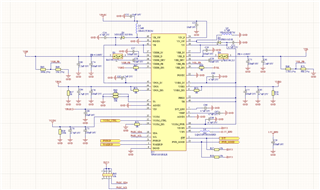Hello,
I have a question about PMIC TPS651851RSLR. On our board, 5V supply (for pins 40 (VB_SW) , 24 (VIN_P) and 10 (VIN))
is switched on/off by switching circuit. In this situation, when 5V was cut off, voltage on VIN wasn't cut off, but changed to about 2V-3V. Maybe it's
because the fact, that after switching PMIC_5V off, there is still 3.3V on pull-up pins (for example I2C or PWR_GOOD), on 45 pin (VIN3P3) and it can be also
on signal lines (for example WAKEUP line). Do you have idea how the voltage is transfered to VIN pin and if it can be dangerous for PMIC in
that state (5V cut off and 3.3V on pull-up lines, on VIN3P3 pin and on signal lines) ?


